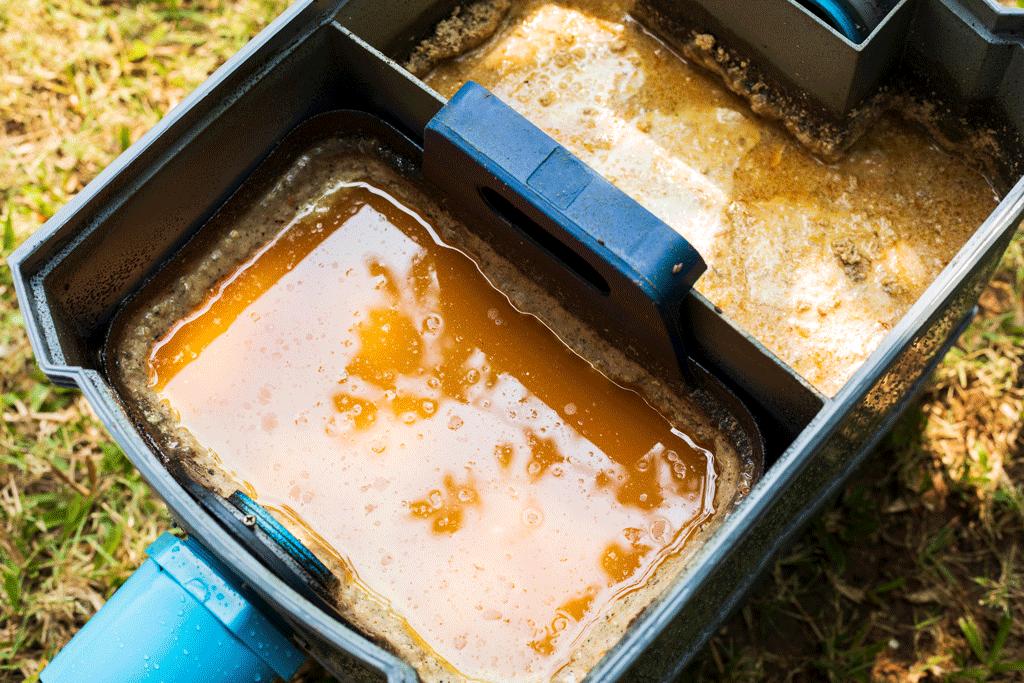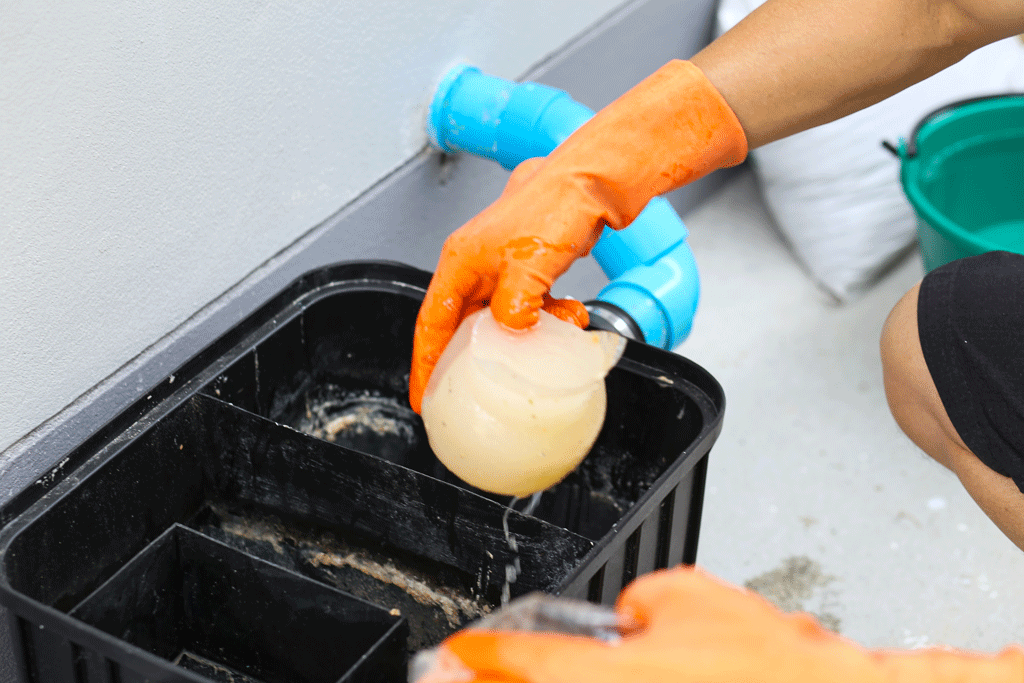Effortless Grease Trap Solutions: A Homeowner’s Guide

Have you ever wondered what a Grease trap is and why it’s essential for your home?
If you’re a homeowner, understanding the role of a Grease trap can be crucial. It’s not just about keeping your plumbing in good shape; it’s about maintaining a healthy, hygienic home environment.
In this article, we delve deep into the world of Grease traps. From their basic function to the intricacies of maintenance and cleaning, we’ve got you covered.
Whether you’re a new homeowner or have been managing your property for years, this guide will provide valuable insights into Grease holding devices management, ensuring your home remains problem-free.
A Detailed Explanation of Grease Traps
Grease traps are an essential component of any household plumbing system, especially in homes with a heavy reliance on kitchen usage.
They are designed to intercept fats, oils, and greases (FOG) before they enter your wastewater disposal system.
This is crucial because FOG can solidify and cause blockages in your pipes, leading to costly repairs and unpleasant odors.
What Is A Grease holding devices
A Grease trap, an essential plumbing device, is engineered to capture greases, fats, oils, and solids, preventing them from entering the wastewater disposal system.
This mechanism is crucial in both commercial and residential settings, particularly in kitchens. Its primary role is to mitigate the risk of blockages in sewer lines, which can be caused by the accumulation of fat, oil, and grease (FOG).
By trapping these substances, a Grease holding trap plays a vital role in maintaining the efficiency and health of plumbing systems. It’s a key component in preventing costly and disruptive sewer backups, ensuring a smooth and efficient wastewater management process.
Also read: Master the Art: How to Clear a Clogged Drain Like a Pro
Understanding Grease Traps: A Comprehensive Guide
The Basics of Grease holding devices Functionality
A Grease trap, a crucial component in modern plumbing, is typically installed under the kitchen sink or buried in the ground outside your home.
Its primary role is to manage the flow of hot, greasy water that comes from your kitchen activities.
When this water enters the grease holding gadget, the device cleverly slows it down. This reduction in speed is vital for the next part of the process.
As the water cools, the grease, which is lighter than water, begins to separate and rise to the top. This separation is crucial for preventing grease-related plumbing issues.
How Grease Trap Protect Your Plumbing
The grease device’s design allows it to store the separated grease effectively. This containment is essential in preventing the grease from continuing down into the sewage system.
If grease were to enter the sewage system, it could solidify and cause significant blockages, leading to costly and inconvenient plumbing emergencies.
By trapping grease, the device ensures the smooth functioning of your home’s plumbing system, making it an indispensable tool for homeowners, especially in areas like Kingman, AZ, and Bullhead City, AZ.
The Role of Grease Traps in Environmental Protection
Beyond protecting your home plumbing, grease devices play a significant role in environmental conservation.
By preventing grease from entering the sewage system, these traps help avoid the contamination of local waterways. This is particularly important in areas like Golden Valley, AZ, and Mohave Valley, AZ, where environmental preservation is a priority.
The Grease holding devices’s ability to intercept fats, oils, and greases (FOG) before they wreak havoc on both plumbing and the environment is a testament to its importance.
Grease Trap Cleaning: Ensuring Efficiency
Regular grease device cleaning is essential for maintaining its efficiency.
Over time, the accumulated grease can harden, reducing the trap’s effectiveness and potentially leading to the very problems it’s designed to prevent.
Homeowners should consider both DIY and professional Grease holding devices cleaning options, with a focus on regular maintenance schedules to ensure their Grease holding devices continue to function optimally.
Understanding how your Grease holding devices works, its benefits, and the importance of regular maintenance, including Grease holding devices cleaning, is crucial for any homeowner.
This knowledge not only helps in maintaining a smooth-running household but also contributes to broader environmental efforts.
The Critical Need for Regular Grease Trap Maintenance
Preventing Health Hazards and Odors
Regular cleaning and maintenance of your grease holding devices are not just recommended practices; they are essential for the health and well-being of your household.
Over time, the grease accumulated in the trap can become a breeding ground for harmful bacteria.
This bacterial growth can lead to the development of unpleasant odors, transforming your kitchen or the area around the Grease holding devices into an unwelcoming environment. These odors are not just a nuisance; they can also be indicative of potential health hazards lurking within unclean Grease holding devices.
Maintaining Efficiency and Functionality
The primary purpose of a Grease trap is to intercept fats, oils, and greases (FOG) before they enter your plumbing system.
However, if the trap is not cleaned regularly, its effectiveness diminishes. An unclean Grease holding device struggles to separate and store grease efficiently, leading to a higher risk of FOG slipping through into the sewage system.
This can result in blockages and back-ups in your plumbing system, turning into a homeowner’s nightmare.
Regular Grease holding devices cleaning ensures that this vital component continues to function as intended, safeguarding your home from plumbing disasters.
Avoiding Costly Repairs and Disruptions
Neglecting Grease holding devices maintenance can lead to significant blockages in your plumbing system. These blockages are not just inconvenient; they can also be costly to repair.
Regular cleaning of your Grease holding devices is a proactive measure that can save you from unexpected expenses and disruptions.
By keeping your Grease holding devices in optimal condition, you’re not only maintaining a clean and healthy home environment but also protecting yourself from the financial burden and inconvenience of emergency plumbing repairs.
Grease Trap Cleaning: A Key Aspect of Home Maintenance
Incorporating Grease holding devices cleaning into your regular home maintenance routine is crucial.
This practice ensures that your Grease holding devices, a key component in your home’s plumbing system, continues to operate effectively.
Regular cleaning prevents the accumulation of grease, which can lead to blockages, and maintains the trap’s ability to protect your plumbing.
Homeowners, especially in areas prone to plumbing issues, should prioritize Grease holding devices maintenance as part of their overall home care strategy.
Regular cleaning and maintenance of your Grease holding devices are vital for maintaining a healthy, odor-free home environment, ensuring the efficiency of your plumbing system, and avoiding costly repairs.
As a homeowner, understanding the importance of Grease holding devices cleaning is key to a well-maintained and smoothly functioning household.
Also read: Your Key to a Problem Free Home | A Guide to Drain Cleaning

Photo By Titikul_B at Shutterstock
Navigating Grease Trap Cleaning: DIY vs. Professional Approach
Understanding DIY Grease holding devices Cleaning
For many homeowners, DIY cleaning methods for their Grease holding devices can seem like a cost-effective and immediate solution.
These methods often involve manually removing the accumulated grease and debris from the trap. While this can be effective for smaller or less frequently used Grease holding devices, it requires a certain level of knowledge and comfort with handling potentially unpleasant materials.
Additionally, DIY cleaning might not always be as thorough as needed, especially for larger or more heavily used systems.
The Challenges of DIY Grease Trap Maintenance
One of the main challenges of DIY Grease holding devices cleaning is ensuring that all the grease, oils, and fats are effectively removed without damaging the trap itself.
Inadequate cleaning can lead to a buildup of materials, eventually causing blockages or inefficiencies in the system. Furthermore, homeowners must also consider the disposal of the waste collected from the Grease holding devices.
Improper disposal can lead to environmental hazards and may violate local regulations.
Advantages of Professional Grease Trap Cleaning Services
Professional Grease holding devices cleaning services offer a level of thoroughness and expertise that is hard to match with DIY methods.
These professionals are equipped with specialized tools and have extensive knowledge of how to effectively clean different types of Grease holding devices. They can ensure that every component of the trap is cleaned properly, preventing future issues and extending the lifespan of the device.
Compliance with Regulations and Standards
One of the significant benefits of opting for professional Grease holding devices cleaning is adherence to local regulations and environmental standards.
Professionals are aware of the legal requirements for disposing of Grease holding devices waste and ensure that their cleaning methods are environmentally friendly.
This not only helps in maintaining compliance but also contributes to environmental conservation efforts.
Tailored Solutions for Different Grease Trap Types
Professional services can provide tailored cleaning solutions based on the type and usage of your Grease holding devices.
Whether it’s a small under-the-sink unit or a large in-ground system, professionals can adjust their cleaning methods to suit the specific needs of your Grease holding devices.
This customized approach ensures that your Grease holding devices are maintained in optimal condition, regardless of its size or the level of usage.
While DIY Grease holding devices cleaning can be a viable option for some homeowners, professional cleaning services offer thoroughness, expertise, and compliance with regulations that DIY methods may lack.
For homeowners who want to ensure that their Grease holding devices are maintained effectively and efficiently, professional cleaning services are a valuable investment.
Maximizing Grease Trap Efficiency: Preventive Measures and Best Practices
Adopting Effective Kitchen Habits
To ensure the optimal functioning of your Grease holding devices, adopting certain kitchen habits is crucial.
These practices not only prolong the life of your Grease holding devices but also significantly reduce the frequency and intensity of required cleanings.
One of the most effective habits is scraping off food residues from plates and cookware into a trash bin before washing them.
This simple action minimizes the amount of grease and solid waste that enters your Grease holding devices, thereby reducing the likelihood of clogs and overflows.
The Role of Sink Strainers in Grease holding devices Maintenance
Using sink strainers is another best practice that can have a significant impact on the efficiency of your Grease holding devices.
Sink strainers act as a first line of defense, catching large food particles and preventing them from entering the Grease holding devices.
By trapping these solids, sink strainers help maintain the flow and functionality of the Grease holding devices, ensuring it can effectively do its job of trapping grease and oils.
Avoiding the Drain for Oil and Grease Disposal
One of the key preventive measures for maintaining a Grease holding device is to avoid pouring oils and grease down the drain.
Disposing of grease and oils in this manner can lead to significant build-up in the Grease holding devices, necessitating more frequent and intensive cleaning.
Instead, homeowners should find alternative disposal methods, such as collecting used oils in a container and disposing of them in the trash or at a designated recycling center.
Regular Monitoring and Early Detection
Regularly monitoring the performance of your Grease holding devices can help in early detection of potential issues.
Homeowners should be aware of signs like slow drainage or unpleasant odors, which could indicate that the Grease holding device is reaching its capacity or not functioning correctly.
Early detection allows for timely intervention, preventing more severe problems down the line.
Educating Household Members
Educating all household members about the importance of these practices is essential. Everyone who uses the kitchen should understand the role of the Grease holding devices and how their actions can impact its efficiency.
This collective effort helps in maintaining the Grease holding devices and avoiding common issues associated with improper use and maintenance.
Scheduled Professional Inspections
In addition to these daily practices, scheduling regular professional inspections of your Grease holding devices can be beneficial.
These inspections can help identify any issues that might not be apparent to the untrained eye and ensure that your Grease holding devices are in top working condition.
Maintaining your Grease holding devices’s efficiency involves a combination of good kitchen habits, regular monitoring, and education.
By implementing these preventive measures and best practices, homeowners can ensure the longevity and effectiveness of their Grease holding devices, ultimately contributing to a smoother and more efficient home plumbing system.

Photo By Tony Stock at Shutterstock
Top 5 Essential Grease Trap Care and Maintenance Tips: Tested and Proven
1. Regular Inspection and Maintenance for Optimal Performance
The cornerstone of effective Grease holding devices management is regular inspection and maintenance.
This routine check ensures that your Grease holding devices are functioning correctly and helps in preventing overflows and blockages, which are common issues in poorly maintained systems.
Regular cleaning not only extends the lifespan of the Grease holding devices but also maintains its efficiency in trapping fats, oils, and grease (FOG).
It’s recommended to schedule these inspections based on the usage level of your kitchen, with more frequent checks for higher usage. [Link to maintenance guide]
2. The Importance of Proper Installation
Proper installation is critical for the efficient functioning of Grease traps.
An incorrectly installed Grease holding device can lead to numerous problems, including reduced efficiency, increased risk of blockages, and even environmental hazards.
It’s essential to ensure that your Grease holding devices are installed by a professional who understands the intricacies of your plumbing system and local regulations.
Proper installation not only ensures compliance with standards but also guarantees that your Grease holding devices will function as intended. [Link to installation services]
3. Utilizing Enzyme Treatments for Enhanced Efficiency
Enzyme treatments can be a game-changer in Grease holding devices maintenance. These treatments involve using biological enzymes to break down FOG, making it easier for the Grease holding devices to function effectively.
Enzymes can also help in reducing odors, a common issue with Grease holding traps.
Regular use of enzyme treatments can significantly reduce the need for frequent cleanings and can prolong the life of your Grease holding devices.
4. Educating Household Members on Best Practices
Education is key in preventing Grease traps issues.
It’s important to inform all household members about what should and shouldn’t go down the drain.
Simple practices like avoiding the disposal of oils and grease down the sink and scraping plates before washing can significantly reduce the load on your Grease holding devices.
Educating your family on these practices is a simple yet effective strategy to ensure the longevity and efficiency of your Grease holding devices. [Link to educational resources]
5. Seeking Professional Assistance for Complex Issues
While regular maintenance can be handled independently to some extent, complex issues require professional assistance.
Experts like Benjamin Franklin Plumbing have the knowledge, tools, and experience to address any Grease holding devices-related problems effectively. They can provide specialized services such as deep cleaning, repairs, and even replacements if necessary.
Professional services ensure that your Grease holding devices are handled correctly and in compliance with all environmental and safety standards.
Maintaining a Grease trap requires a combination of regular maintenance, proper installation, the use of enzyme treatments, education, and professional assistance.
By following these top tips and strategies, homeowners can ensure the efficient and effective operation of their Grease holding devices, preventing plumbing issues and contributing to a cleaner and safer environment.
Advanced Insights into Grease Traps Management
Selecting the Right Grease holding devices for Your Home
Choosing the appropriate Grease traps for your home is a critical decision that can significantly impact the efficiency of your plumbing system.
The size and type of Grease traps you need depends on several factors, including the size of your household, the amount of cooking you do, and the layout of your plumbing system.
For smaller households with less frequent cooking, a compact under-sink Grease holding devices might be sufficient. However, for larger families or homes where cooking is a daily affair, a more robust system may be required.
Understanding Different Types of Grease Traps
Grease traps come in various designs and capacities, each suited to different needs. Traditional concrete traps are common in older homes but are being replaced by more efficient and environmentally friendly options.
Modern Grease traps are often made of lighter materials like plastics or metals, which are easier to clean and maintain.
Additionally, some advanced models come with automatic cleaning functions, reducing the need for manual maintenance.
Factors to Consider When Choosing a Grease holding devices
When selecting Grease traps, consider factors such as capacity, ease of maintenance, durability, and compliance with local regulations.
It’s also important to think about the installation process and whether your chosen model is compatible with your existing plumbing system.
Consulting with a professional plumber can provide valuable insights into the best type of Grease holding devices for your home.
Innovative Technologies in Grease Trap Design
The world of Grease traps is evolving, with new technologies emerging to enhance their efficiency and environmental friendliness.
Innovations in Grease holding devices design are focused on improving the separation of FOG from wastewater, reducing odors, and making maintenance easier.
Automatic Grease Removal Units (AGRU)
One of the significant advancements in Grease holding devices technology is the development of Automatic Grease Removal Units (AGRU). These units are designed to automatically and continuously remove the trapped grease, reducing the need for manual cleaning. AGRUs are particularly beneficial for commercial settings or homes with high kitchen usage.
Smart Grease Traps with Monitoring Capabilities
Smart Grease holding traps equipped with sensors and internet connectivity are becoming increasingly popular. These devices can monitor grease levels, temperature, and other parameters, sending alerts when cleaning or maintenance is needed.
This technology not only makes Grease holding devices management more efficient but also helps in preventing emergencies caused by overflows or blockages.
Eco-Friendly Grease Traps Solutions
Environmental concerns have led to the development of eco-friendly Grease holding devices solutions. These include models that are designed for easier recycling of trapped grease, turning a waste product into a resource.
Some advanced Grease holding devices also feature designs that minimize energy consumption, aligning with the growing trend of eco-conscious home maintenance.
Enhancing Home Plumbing with Grease holding devices Innovations
Grease holding devices Sizing and Capacity: Finding the Perfect Fit
Selecting the right size and capacity for your Grease holding devices is crucial for its effectiveness and efficiency.
The size of the Grease holding devices you need depends on various factors, including the size of your household, the frequency and type of cooking you do, and the specific layout of your plumbing system.
For smaller households or those with less frequent cooking, a compact under-sink Grease holding devices might suffice. In contrast, larger families or homes with heavy kitchen usage might require a more substantial system.
Assessing Your Household’s Needs
To determine the appropriate size for your Grease holding devices, consider the volume of wastewater your household generates and the amount of grease typically produced during cooking.
It’s also important to factor in future needs, as underestimating your requirements can lead to frequent overflows and maintenance issues.
Consulting with Professionals
Consulting with a plumbing professional can provide valuable insights into the best Grease holding device size for your home.
They can assess your household’s specific needs and recommend Grease traps that not only fits your current situation but also accommodates potential changes in your lifestyle or household size.

Photo By Asti Mak at Shutterstock
Grease Traps Materials and Durability: Choosing Quality
The material of your Grease holding devices significantly impacts its durability, maintenance requirements, and overall performance.
Grease holding devices are commonly made from materials like plastic, stainless steel, or concrete, each offering different benefits and drawbacks.
Plastic Grease Traps
Plastic Grease holding devices are lightweight, easy to install, and resistant to corrosion. They are a popular choice for residential settings due to their affordability and ease of maintenance.
However, they may not be as durable as other materials and might require more frequent replacement.
Stainless Steel Grease Trap
Stainless steel Grease holding devices are known for their durability and resistance to corrosion. They are a great option for households that require a robust and long-lasting solution.
While they may be more expensive upfront, their longevity can make them a cost-effective choice in the long run.
Concrete Grease Trap
Concrete Grease holding devices are often used in commercial settings due to their large capacity and strength.
They are less common in residential homes but can be an option for households with extensive Grease holding devices needs. Concrete traps are durable but can be challenging to install and maintain.
Grease Trap Maintenance Tools and Accessories
Proper maintenance of your Grease holding devices is essential for its efficient operation. Various tools and accessories can make the maintenance process easier and more effective.
Grease holding devices Cleaning Tools
Specialized cleaning tools, such as scrapers, brushes, and pumps, are designed to remove accumulated grease and debris from your Grease holding devices.
These tools can help you perform thorough cleanings, ensuring that your Grease holding traps remain in optimal condition.
Grease Trap Additives and Treatments
There are various additives and treatments available that can help break down grease and reduce odors in your Grease holding devices.
These products can be a valuable addition to your maintenance routine, especially for households with high kitchen usage.
Grease Traps Alarms and Monitoring Systems
Modern Grease holding devices can be equipped with alarms and monitoring systems that alert you when the trap needs cleaning or when there are potential issues. These systems can be particularly useful for preventing overflows and ensuring timely maintenance.
Enhancing your home’s plumbing system with the right Grease holding devices involves careful consideration of size, material, and maintenance tools.
By understanding these aspects and choosing a Grease holding device that fits your household’s specific needs, you can ensure efficient wastewater management and a smoothly functioning home.
Optimizing Your Home with Advanced Grease Traps Management
Grease Trap Efficiency and Environmental Impact
In today’s environmentally conscious world, the efficiency of a Grease holding device extends beyond its functional role in your home.
It also plays a significant part in reducing environmental impact. An efficient Grease holding device not only prevents blockages in your plumbing system but also minimizes the amount of fats, oils, and grease (FOG) that enters the sewage system.
This reduction is crucial in preventing the contamination of local water bodies and reducing the strain on municipal wastewater treatment facilities.
Eco-Friendly Practices in Grease Trap Management
To enhance the environmental friendliness of your Grease holding devices, consider practices like recycling the collected grease for biofuel production.
Some services specialize in converting Grease holding devices waste into renewable energy, offering an eco-friendly solution to waste disposal.
Additionally, using biodegradable and non-toxic cleaning agents for your Grease holding devices maintenance can further reduce environmental impact.
Innovations in Grease Trap Technology
The market is seeing a rise in innovative Grease holding devices technologies that focus on energy efficiency and reduced environmental footprint.
These advancements include automated systems that optimize grease removal and reduce the need for manual cleaning, as well as models designed for easier disassembly and recycling at the end of their lifespan.
Grease Traps Safety and Health Considerations
While Grease traps are essential for maintaining your plumbing system, they also have implications for safety and health in your home.
A poorly maintained Grease holding device can become a breeding ground for bacteria and pests, posing health risks to your household.
Preventing Health Risks
Regular cleaning and proper maintenance of your Grease holding devices are key to preventing these health hazards.
Ensuring that your Grease holding devices is functioning correctly and free from excessive buildup can significantly reduce the risk of unpleasant odors and bacterial growth.
Safety Measures in Grease holding devices Maintenance
When maintaining or cleaning your Grease holding devices, it’s important to follow safety guidelines.
This includes wearing protective gear like gloves and masks, especially when dealing with older or heavily used traps. If you’re unsure about the safety procedures, it’s advisable to seek professional assistance.
Long-Term Planning for Grease Traps Upkeep
Planning for the long-term upkeep of your Grease holding devices can save you time, money, and hassle in the future.
This involves not only regular maintenance but also considering the lifespan of your Grease holding devices and planning for eventual replacement.
Budgeting for Grease Trap Maintenance
Setting aside a budget for regular Grease holding devices maintenance and potential repairs can help you avoid unexpected expenses.
It’s also wise to research and compare different service providers to find one that offers quality service at a reasonable price.
Planning for Replacement
As with any component of your home, Grease holding devices have a finite lifespan. Staying aware of the age and condition of your Grease holding devices can help you plan for its eventual replacement before it becomes an emergency.
Upgrading to a newer model can also bring the benefits of improved efficiency and newer technologies.
Optimizing your home with advanced Grease holding devices management involves a holistic approach that considers efficiency, environmental impact, safety, health, and long-term planning.
By addressing these aspects, you can ensure that your Grease holding devices contribute positively to the functionality and sustainability of your home.
Benjamin Franklin Plumbing of Mohave County, AZ: Your Go-to Grease Trap Solution Experts
Comprehensive Grease Trap Services in Mohave County
Benjamin Franklin Plumbing, a renowned service provider in Mohave County, AZ, specializes in offering comprehensive solutions for all your Grease holding devices needs.
Their expertise is not limited to just one aspect of Grease holding devices management; they provide a full range of services that encompass installation, regular maintenance, and emergency response.
Whether you reside in Kingman, Bullhead City, Golden Valley, or Mohave Valley, their team is equipped to handle any Grease holding devices-related challenges you might face.
Expert Installation Services
One of the critical services offered by Benjamin Franklin Plumbing is the professional installation of Grease holding devices.
Understanding that proper installation is crucial for the efficient functioning of these devices, their team ensures that every Grease holding device is installed with precision and care.
They consider the specific needs of your property and plumbing system, ensuring that the Grease holding devices integrate seamlessly and functions optimally.
Regular Maintenance for Long-Term Efficiency
Regular maintenance is vital for the longevity and effectiveness of your Grease holding devices, and Benjamin Franklin Plumbing excels in this area.
Their maintenance services are designed to keep your Grease holding devices in top condition, preventing common issues like blockages and overflows.
Regular cleaning and inspections by their skilled technicians can save you from costly repairs and ensure that your Grease holding devices complies with local health and safety standards.
Emergency Services for Urgent Grease holding devices Issues
In the event of an emergency, such as a sudden blockage or overflow, Benjamin Franklin Plumbing offers prompt and reliable emergency services.
Their team is ready to respond quickly to your call, ensuring that any urgent Grease holding devices issues are resolved efficiently, minimizing the impact on your daily life and property.
Trusted and Reliable in Mohave County
The reputation of Benjamin Franklin Plumbing in Mohave County is built on trust, reliability, and high-quality service.
Their commitment to providing excellent Grease holding devices solutions is evident in the positive reviews and ratings they have received from satisfied customers.
Homeowners in the area can rely on their expertise for all Grease holding devices-related needs, assured of receiving professional, courteous, and effective service.
Contact Information for Immediate Assistance
For homeowners in Mohave County looking for expert Grease holding devices services, Benjamin Franklin Plumbing is just a call away.
You can reach them at # 928-224-8669 for immediate assistance, consultations, or to schedule a service. Their team is ready to provide you with the best solutions for your Grease holding devices, ensuring your home’s plumbing system remains in excellent condition.
Benjamin Franklin Plumbing of Mohave County, AZ, stands as a beacon of excellence in Grease holding devices services.
From expert installation and regular maintenance to emergency responses, their team is equipped to handle all aspects of Grease holding devices management, providing peace of mind and reliability to homeowners in the region.
Conclusion
Remember, the key to a smooth-running home often lies in the details, like maintaining your Grease traps. This essential component of your home’s plumbing system plays a pivotal role in preventing blockages and ensuring efficient wastewater management.
Whether you’re a DIY enthusiast or prefer professional assistance, understanding and properly caring for your Grease holding devices is crucial in your home maintenance routine.
A well-maintained Grease holding device not only prevents plumbing disasters but also contributes to a cleaner, more hygienic home environment.
Regular cleaning and maintenance of your Grease holding devices, be it through DIY methods or professional Grease holding devices cleaning services, can significantly reduce the risk of unpleasant odors and costly repairs.
It’s a task that demands attention but pays off by preserving the integrity of your plumbing system.
We invite you to share your experiences and insights in the comments below. Your stories about managing Grease holding devices issues, the challenges you’ve faced, and the solutions you’ve discovered can be incredibly helpful to others.
Whether it’s a tip on Grease trap maintenance, a recommendation for a product, or a tale of a plumbing predicament, your input can help build a community of informed and proactive homeowners.
When was the last time you checked your Grease holding devices?
Regular inspection and maintenance can make a significant difference in the overall well-being of your homes.
If you’ve faced challenges with your Grease holding devices, or if you have tips to share, let’s hear them.
Your contribution can help others navigate the complexities of Grease holding devices maintenance, ensuring their homes run as smoothly as yours.

Photo By Faizal Ramli at Shutterstock
FAQs
1.What is the primary function of a Grease holding devices?
A Grease holding devices is designed to intercept FOG from wastewater before it enters the sewage system, preventing blockages.
2.How often should a Grease holding devices be cleaned?
It depends on usage, but generally, it should be cleaned every 1-3 months.
3.Can I clean my Grease holding devices myself?
While DIY methods exist, professional cleaning ensures thoroughness and compliance with disposal regulations.
4.What happens if a Grease holding trap is not maintained?
Neglecting maintenance can lead to blockages, back-ups, and unpleasant odors.
5.Are Grease holding devices required in all homes?
Not all homes require them, but they are crucial in houses with heavy kitchen use.
6.What are some signs that my Grease trap needs cleaning?
Slow drainage, unpleasant odors, and visible grease build-up are common indicators.
7.Can Grease trap handle all kitchen waste?
No, they are designed for FOG only. Solid food waste should be disposed of separately.
8.Is it expensive to install a Grease holding devices?
Costs vary based on size and type, but it’s a worthwhile investment for long-term plumbing health.
9.How do Grease holding devices benefit the environment?
They prevent FOG from entering and harming waterways, contributing to environmental protection.
10.Can Benjamin Franklin Plumbing help with Grease trap installation?
Yes, they offer installation services along with maintenance and repairs.
See our most recent blog on this topic here.
Check out our reviews here

















